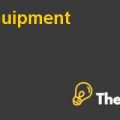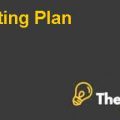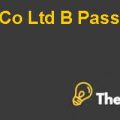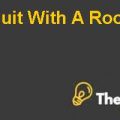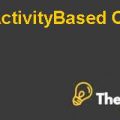
BALANCE SHEET
The balance sheet of the company shows a similar picture as that of the Income Statement of the company. The company’s total assets increase in the first three years but after that they fall drastically in the next two years as the receivables and amount of cash of the company are decreasing simultaneously that is reducing total current assets, which is causing a sharp decline in the total assets.
In the other half of the balance sheet, the current liability seems to come to a halt; this is mainly because current liability is taken as 0.62% of sales of that year. Moreover, reduction in sales had brought reduction in liability but the company is not benefiting from it, which is a clear reflection in the return on equity of the company that is falling by a steep pace in the last three years. This reduction indicates that with the passage of time, the investment starts to lose its value and the return on it starts to reduce until the market completely rejects the product.
|
Forecasted Balance Sheets, 2010–2012 ($000s) |
|||||
|
2010 |
2011 |
2012 |
2013 |
2014 |
|
| Cash |
3,960 |
4,752 |
4,752 |
4,224 |
3,465 |
| Accounts receivable |
19,726 |
23,671 |
23,671 |
21,041 |
17,260 |
| Inventories |
13,865 |
16,638 |
16,638 |
14,789 |
12,132 |
| Prepaid expenses |
480 |
576 |
576 |
512 |
420 |
| Total current assets |
38,031 |
45,637 |
45,637 |
40,566 |
33,277 |
| Property, plant & equipment at cost |
8,182 |
9,082 |
9,982 |
10,882 |
11,782 |
| Less: Accumulated depreciation |
2,179 |
2,793 |
3,474 |
4,223 |
5,039 |
| Net property, plant & equipment |
6,003 |
6,289 |
6,508 |
6,659 |
6,743 |
| Total assets |
44,034 |
51,926 |
52,145 |
47,226 |
40,020 |
| Accounts payable |
4,799 |
5,759 |
5,759 |
5,119 |
4,199 |
| Notes payable (Balancing Figure) |
14,320 |
16,930 |
13,341 |
13,342 |
13,343 |
| Accrued expenses |
876 |
1,051 |
1,051 |
934 |
767 |
| Income taxes payable |
226 |
264 |
254 |
219 |
168 |
| Other current liabilities |
744 |
893 |
893 |
794 |
651 |
| Total current liabilities |
20,966 |
24,897 |
21,299 |
20,408 |
19,128 |
| Common stock at par value |
15 |
15 |
15 |
15 |
15 |
| Paid in capital in excess of par value |
7,980 |
7,980 |
7,980 |
7,980 |
7,980 |
| Retained earnings |
15,087 |
19,049 |
22,866 |
26,151 |
28,672 |
| Total shareholders' equity |
23,067 |
27,029 |
30,846 |
34,131 |
36,652 |
| Total liabilities & shareholders' equity |
44,034 |
51,926 |
52,145 |
54,540 |
55,780 |
| Number of shares outstanding |
1,492 |
1,492 |
1,492 |
1,492 |
1,492 |
| ROE | 0.15 | 0.15 | 0.12 | 0.10 | 0.07 |
| Book Value per Share | 15.5 | 18.1 | 20.7 | 22.9 | 24.6 |
INVESTMENT APPRAISAL
The need for continuous updating and innovation in the company has up taken a project for a major new product line, which will increase sales, profits and cash flows. The company requires $2.2 million of finance to up take this project; the company has two options to finance this project that us either to undertake debt finance by taking further loan notes and pledging 90% value of the receivables or the company can sell its shares privately.
Under both conditions, Discounted Cash Flow has to be generated as both finance options have different risk profiles; both options will lead to different cost of capital of the company calculated through WACC. Under each option, net present value has to be calculated and the option that has a greater NPV will be the most feasible option for the company.
The discounted cash flow has been conducted through data provided as per the case,
|
Discounted Cash Flow |
|||||||
|
Investment In New Product Line (USD millions) |
|||||||
|
Year |
2010 |
2011 |
2012 |
2013 |
2014 |
2015 |
2016 |
| Initial Investment |
(2.20) |
|
|
|
|
|
|
| Sales revenue |
|
21.60 |
28.00 |
28.00 |
11.00 |
5.00 |
|
| Gross Profit Margin |
- |
4.54 |
5.88 |
5.88 |
2.31 |
1.05 |
- |
| Advertising |
|
(0.30) |
|
|
|
|
|
| Taxable Profit |
(2.20) |
4.24 |
5.88 |
5.88 |
2.31 |
1.05 |
- |
| Taxation |
|
|
(1.69) |
(2.35) |
(2.35) |
(0.92) |
(0.42) |
| Profit After Taxation |
(2.20) |
4.24 |
4.19 |
3.53 |
(0.04) |
0.13 |
(0.42) |
| Working Capital |
|
(5.65) |
(7.32) |
(7.32) |
(2.88) |
(1.31) |
- |
| Add Back Depreciation Expense |
|
0.44 |
0.44 |
0.44 |
0.44 |
0.44 |
- |
| Working Capital - Recovered |
|
|
|
|
|
24.49 |
|
| Net Cash Flows |
(2.20) |
(0.97) |
(2.70) |
(3.36) |
(2.48) |
23.74 |
(0.42) |
WACC & CAPM
For the calculation of CAMP, equity risk premium is taken as 6% that is given in the case. Risk free return is taken as 10-year treasury bond that is 3.70% as provided in exhibit but for the calculation for beta, the beta of competitive companies have been taken un-geared to calculate beta asset. The average of the beta asset of the competitive companies is assumed to be the beta asset of the industry, which is then geared by the data of the Flash Drive company that gives a beta equity of 1.38 (Calculation of beta asset/ industry beta is conducted in exhibit-4)....................................
This is just a sample partial case solution. Please place the order on the website to order your own originally done case solution.

